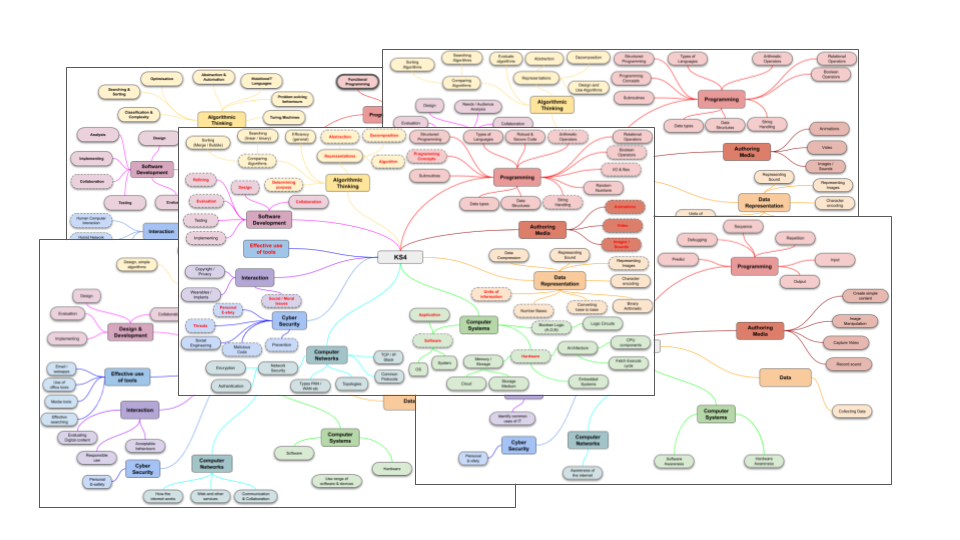Categorising content across the National Centre
25 February 2020

Just over 15 months ago, we were in the process of planning for the delivery of the National Centre for Computing Education. During this time, we began to think about the significant challenge we’d face in organising and talking about our subject. Across the many programmes we’d deliver, we would need to talk about subject content in a consistent, flexible, and clear way.
There are, of course, many existing approaches to dividing up the subject matter, in the form of exam specifications, textbooks, schemes of learning, and various progression guides. We reviewed many of these and eventually decided upon three principles for our organisational structure:
- It should represent the whole of computing, incorporating computer science, information technology, and digital literacy
- Our structure should be able to be applied across phases; the concepts and skills encountered by five year olds should be able to be categorised using the same tool as for GCSE students
- The structure should be focused on the English national curriculum, but be independent of any particular exam board and adapted to suit new curricula in the future
- Computing as a discipline is a broad mixture of concepts and skills that need to be represented in any structure
Over many iterations we reviewed specifications, schemes of work, existing frameworks, and of course, the national curriculum. We captured key knowledge and skills via concept maps and identified key and recurrent themes.
Finally, we identified ten themes which we felt represented the subject as it exists in England today:
| Taxonomy strand | Description |
|---|---|
| Algorithms | Being able to comprehend, design, create, and evaluate algorithms |
| Programming | Writing software to allow computers to solve problems |
| Data and Information | How data is stored, organised, and used to represent real-world artefacts and scenarios |
| Computer systems | What is a computer, how do its constituent parts function together as a whole |
| Networks | Understand how networks can be used to retrieve and share information and come with associated risks |
| Creating media | Select and create a rane of media including text, images, sounds and video |
| Design and development | The activities involved in planning, creating and evaluating computing artefacts |
| Effective use of tools | Use software tools to support computing work |
| Impact of technology | How individuals, systems, and society interact with computer systems |
| Safety and security | Understanding risks when using technology and how to protect individuals and systems |
This approach was rapidly adopted across our early work as a high-level tool to categorise objectives, measure curriculum coverage, and organise content. However, what it didn’t (and still doesn’t) do was address how or when content is taught. It includes a vague sense of progression, largely based on the national curriculum and its expectations of skills and concepts taught at each Key Stage, but not enough to work directly from it.
To address this need, other approaches were developed, which adapted to specific programmes or content, whilst continuing to be underpinned by what we refer to as our taxonomy.
For example, at A level (Computer Science), some strands take a back seat. It is safe to assume that by this stage, learners should be able to make effective use of available tools, create (or source) appropriate media, and keep themselves safe. Learners may apply the associate skills and concepts, but these are not explicitly taught or directly assessed. For these reasons, these strands don’t really feature in content like Isaac CS.
When creating teaching materials, at any Key Stage, we’re unlikely to write a unit of work per strand, as the content will be taught in context with a single unit spanning several strands of our taxonomy. Some strands are rich in concepts, whereas others primarily deal with skills, so the team chooses to weave some strands, such as ‘safety and security’ across every unit.
When writing training courses, we tend to group learning objectives thematically to cover all, some, or multiple taxonomy strands. When question-writing, our authors may design a question to fit a particular strand, but may find that it also fits in other strands.
All of the above are acceptable ways to interpret and apply our taxonomy, which helps us as we strive for consistency and quality.
What next?
- Review the taxonomy strands and consider if and how it represents computing in your school
- In which strands are you, your colleagues, and your learners confident?
- Share your thoughts and feedback regarding the taxonomy via research@teachcomputing.org
About the author

James Robinson, Senior Learning Manager (Pedagogy), Raspberry Pi Foundation